International Marketing Report: Sainsbury's Case Study - HND
VerifiedAdded on 2022/12/27
|10
|2762
|48
Report
AI Summary
This report delves into the realm of international marketing, analyzing key concepts and strategies through the lens of Sainsbury's, a UK-based supermarket chain. The report commences with an analysis of the scope and core concepts of international marketing, examining the rationale behind a company's decision to market internationally, and outlining various market entry routes. It then assesses the opportunities and challenges associated with international marketing for an organization. The second part of the report evaluates criteria for selecting international markets, explores different market entry strategies such as licensing, franchising, and exporting, and discusses their respective advantages and disadvantages. The report culminates in applying these evaluation criteria and entry strategies to Sainsbury's, offering recommendations for its international expansion. This report provides a comprehensive overview of international marketing principles, illustrated with practical examples related to Sainsbury's operations and market entry considerations.
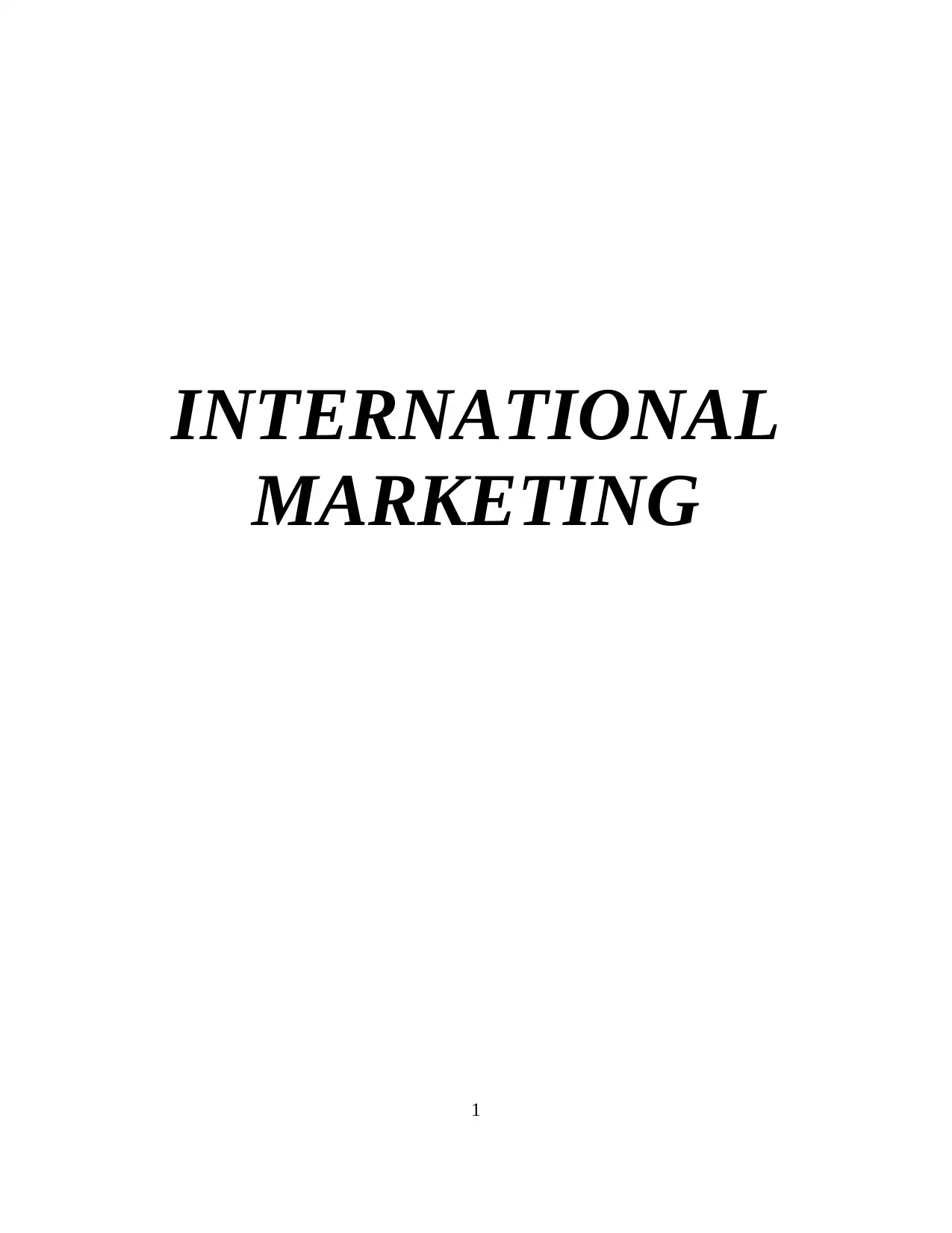
INTERNATIONAL
MARKETING
1
MARKETING
1
Paraphrase This Document
Need a fresh take? Get an instant paraphrase of this document with our AI Paraphraser
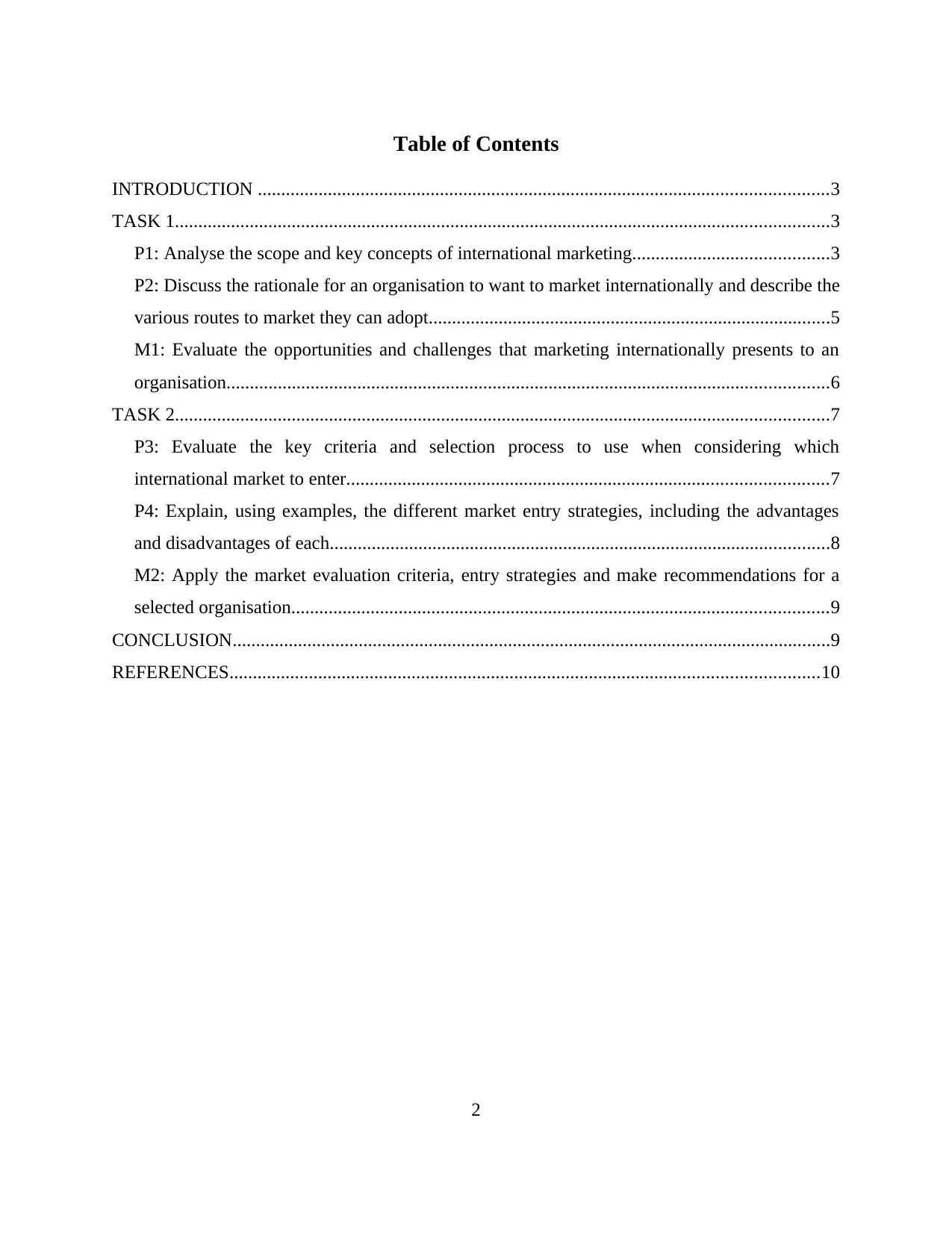
Table of Contents
INTRODUCTION ..........................................................................................................................3
TASK 1............................................................................................................................................3
P1: Analyse the scope and key concepts of international marketing..........................................3
P2: Discuss the rationale for an organisation to want to market internationally and describe the
various routes to market they can adopt......................................................................................5
M1: Evaluate the opportunities and challenges that marketing internationally presents to an
organisation.................................................................................................................................6
TASK 2............................................................................................................................................7
P3: Evaluate the key criteria and selection process to use when considering which
international market to enter.......................................................................................................7
P4: Explain, using examples, the different market entry strategies, including the advantages
and disadvantages of each...........................................................................................................8
M2: Apply the market evaluation criteria, entry strategies and make recommendations for a
selected organisation...................................................................................................................9
CONCLUSION................................................................................................................................9
REFERENCES..............................................................................................................................10
2
INTRODUCTION ..........................................................................................................................3
TASK 1............................................................................................................................................3
P1: Analyse the scope and key concepts of international marketing..........................................3
P2: Discuss the rationale for an organisation to want to market internationally and describe the
various routes to market they can adopt......................................................................................5
M1: Evaluate the opportunities and challenges that marketing internationally presents to an
organisation.................................................................................................................................6
TASK 2............................................................................................................................................7
P3: Evaluate the key criteria and selection process to use when considering which
international market to enter.......................................................................................................7
P4: Explain, using examples, the different market entry strategies, including the advantages
and disadvantages of each...........................................................................................................8
M2: Apply the market evaluation criteria, entry strategies and make recommendations for a
selected organisation...................................................................................................................9
CONCLUSION................................................................................................................................9
REFERENCES..............................................................................................................................10
2
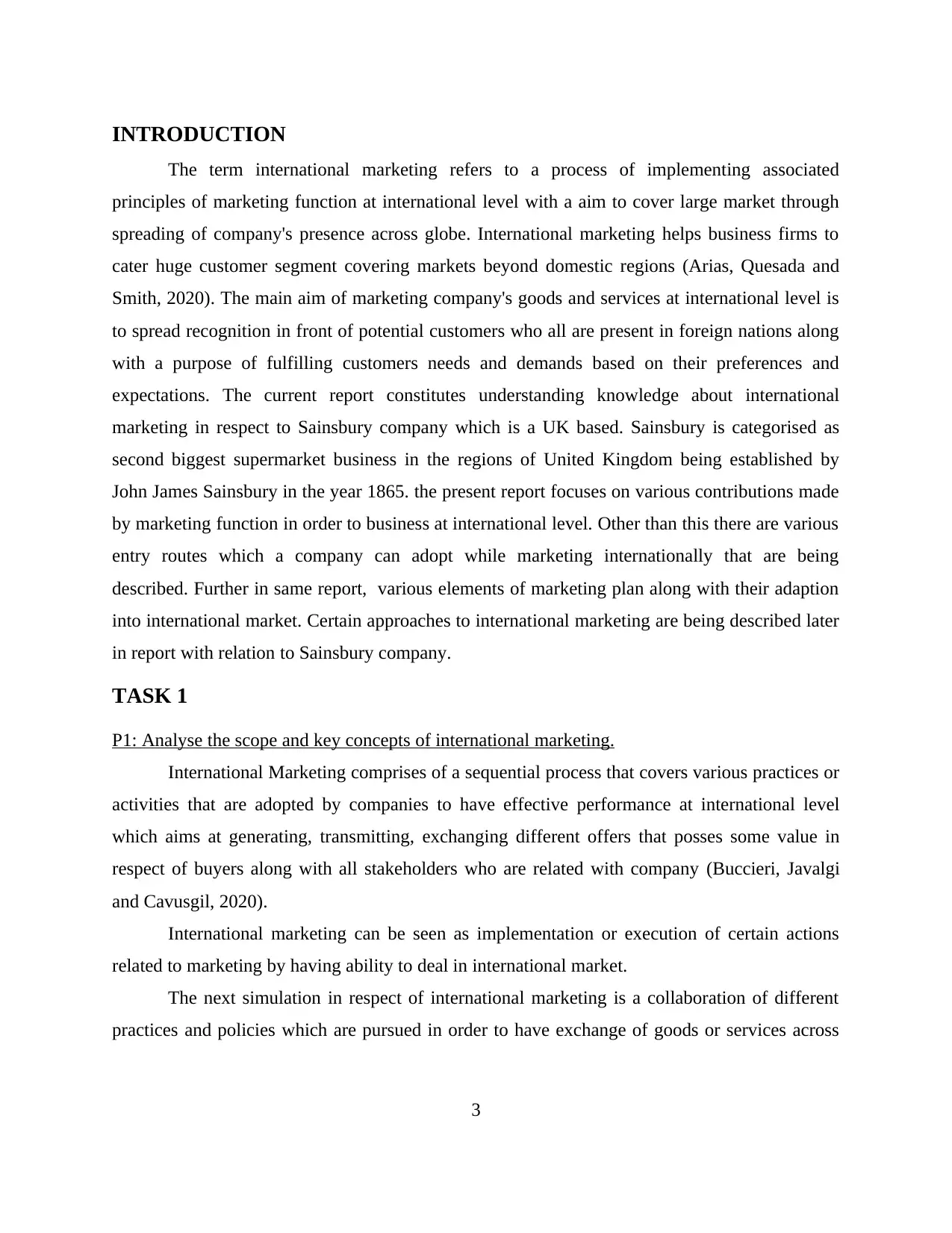
INTRODUCTION
The term international marketing refers to a process of implementing associated
principles of marketing function at international level with a aim to cover large market through
spreading of company's presence across globe. International marketing helps business firms to
cater huge customer segment covering markets beyond domestic regions (Arias, Quesada and
Smith, 2020). The main aim of marketing company's goods and services at international level is
to spread recognition in front of potential customers who all are present in foreign nations along
with a purpose of fulfilling customers needs and demands based on their preferences and
expectations. The current report constitutes understanding knowledge about international
marketing in respect to Sainsbury company which is a UK based. Sainsbury is categorised as
second biggest supermarket business in the regions of United Kingdom being established by
John James Sainsbury in the year 1865. the present report focuses on various contributions made
by marketing function in order to business at international level. Other than this there are various
entry routes which a company can adopt while marketing internationally that are being
described. Further in same report, various elements of marketing plan along with their adaption
into international market. Certain approaches to international marketing are being described later
in report with relation to Sainsbury company.
TASK 1
P1: Analyse the scope and key concepts of international marketing.
International Marketing comprises of a sequential process that covers various practices or
activities that are adopted by companies to have effective performance at international level
which aims at generating, transmitting, exchanging different offers that posses some value in
respect of buyers along with all stakeholders who are related with company (Buccieri, Javalgi
and Cavusgil, 2020).
International marketing can be seen as implementation or execution of certain actions
related to marketing by having ability to deal in international market.
The next simulation in respect of international marketing is a collaboration of different
practices and policies which are pursued in order to have exchange of goods or services across
3
The term international marketing refers to a process of implementing associated
principles of marketing function at international level with a aim to cover large market through
spreading of company's presence across globe. International marketing helps business firms to
cater huge customer segment covering markets beyond domestic regions (Arias, Quesada and
Smith, 2020). The main aim of marketing company's goods and services at international level is
to spread recognition in front of potential customers who all are present in foreign nations along
with a purpose of fulfilling customers needs and demands based on their preferences and
expectations. The current report constitutes understanding knowledge about international
marketing in respect to Sainsbury company which is a UK based. Sainsbury is categorised as
second biggest supermarket business in the regions of United Kingdom being established by
John James Sainsbury in the year 1865. the present report focuses on various contributions made
by marketing function in order to business at international level. Other than this there are various
entry routes which a company can adopt while marketing internationally that are being
described. Further in same report, various elements of marketing plan along with their adaption
into international market. Certain approaches to international marketing are being described later
in report with relation to Sainsbury company.
TASK 1
P1: Analyse the scope and key concepts of international marketing.
International Marketing comprises of a sequential process that covers various practices or
activities that are adopted by companies to have effective performance at international level
which aims at generating, transmitting, exchanging different offers that posses some value in
respect of buyers along with all stakeholders who are related with company (Buccieri, Javalgi
and Cavusgil, 2020).
International marketing can be seen as implementation or execution of certain actions
related to marketing by having ability to deal in international market.
The next simulation in respect of international marketing is a collaboration of different
practices and policies which are pursued in order to have exchange of goods or services across
3
⊘ This is a preview!⊘
Do you want full access?
Subscribe today to unlock all pages.

Trusted by 1+ million students worldwide
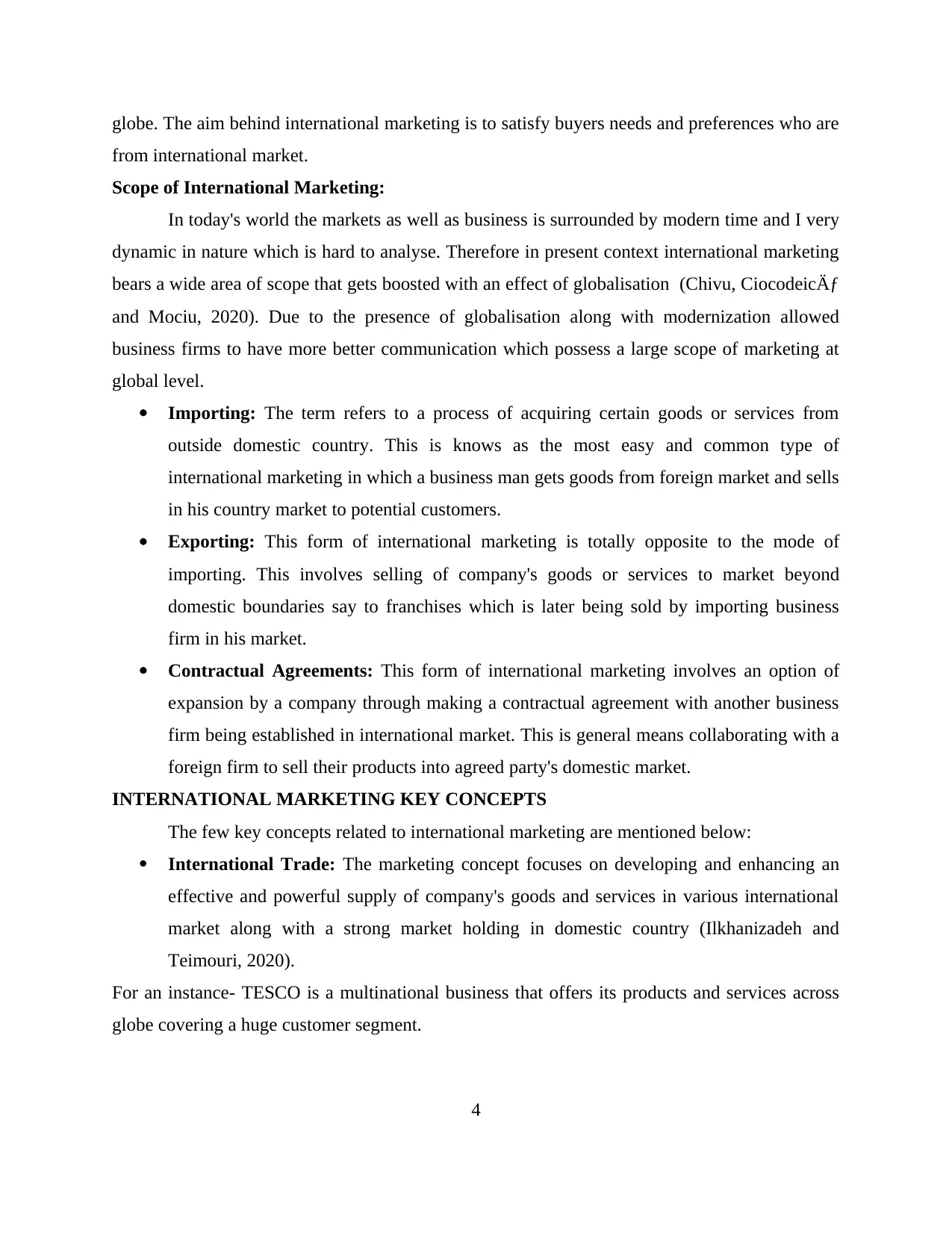
globe. The aim behind international marketing is to satisfy buyers needs and preferences who are
from international market.
Scope of International Marketing:
In today's world the markets as well as business is surrounded by modern time and I very
dynamic in nature which is hard to analyse. Therefore in present context international marketing
bears a wide area of scope that gets boosted with an effect of globalisation (Chivu, Ciocodeică
and Mociu, 2020). Due to the presence of globalisation along with modernization allowed
business firms to have more better communication which possess a large scope of marketing at
global level.
Importing: The term refers to a process of acquiring certain goods or services from
outside domestic country. This is knows as the most easy and common type of
international marketing in which a business man gets goods from foreign market and sells
in his country market to potential customers.
Exporting: This form of international marketing is totally opposite to the mode of
importing. This involves selling of company's goods or services to market beyond
domestic boundaries say to franchises which is later being sold by importing business
firm in his market.
Contractual Agreements: This form of international marketing involves an option of
expansion by a company through making a contractual agreement with another business
firm being established in international market. This is general means collaborating with a
foreign firm to sell their products into agreed party's domestic market.
INTERNATIONAL MARKETING KEY CONCEPTS
The few key concepts related to international marketing are mentioned below:
International Trade: The marketing concept focuses on developing and enhancing an
effective and powerful supply of company's goods and services in various international
market along with a strong market holding in domestic country (Ilkhanizadeh and
Teimouri, 2020).
For an instance- TESCO is a multinational business that offers its products and services across
globe covering a huge customer segment.
4
from international market.
Scope of International Marketing:
In today's world the markets as well as business is surrounded by modern time and I very
dynamic in nature which is hard to analyse. Therefore in present context international marketing
bears a wide area of scope that gets boosted with an effect of globalisation (Chivu, Ciocodeică
and Mociu, 2020). Due to the presence of globalisation along with modernization allowed
business firms to have more better communication which possess a large scope of marketing at
global level.
Importing: The term refers to a process of acquiring certain goods or services from
outside domestic country. This is knows as the most easy and common type of
international marketing in which a business man gets goods from foreign market and sells
in his country market to potential customers.
Exporting: This form of international marketing is totally opposite to the mode of
importing. This involves selling of company's goods or services to market beyond
domestic boundaries say to franchises which is later being sold by importing business
firm in his market.
Contractual Agreements: This form of international marketing involves an option of
expansion by a company through making a contractual agreement with another business
firm being established in international market. This is general means collaborating with a
foreign firm to sell their products into agreed party's domestic market.
INTERNATIONAL MARKETING KEY CONCEPTS
The few key concepts related to international marketing are mentioned below:
International Trade: The marketing concept focuses on developing and enhancing an
effective and powerful supply of company's goods and services in various international
market along with a strong market holding in domestic country (Ilkhanizadeh and
Teimouri, 2020).
For an instance- TESCO is a multinational business that offers its products and services across
globe covering a huge customer segment.
4
Paraphrase This Document
Need a fresh take? Get an instant paraphrase of this document with our AI Paraphraser
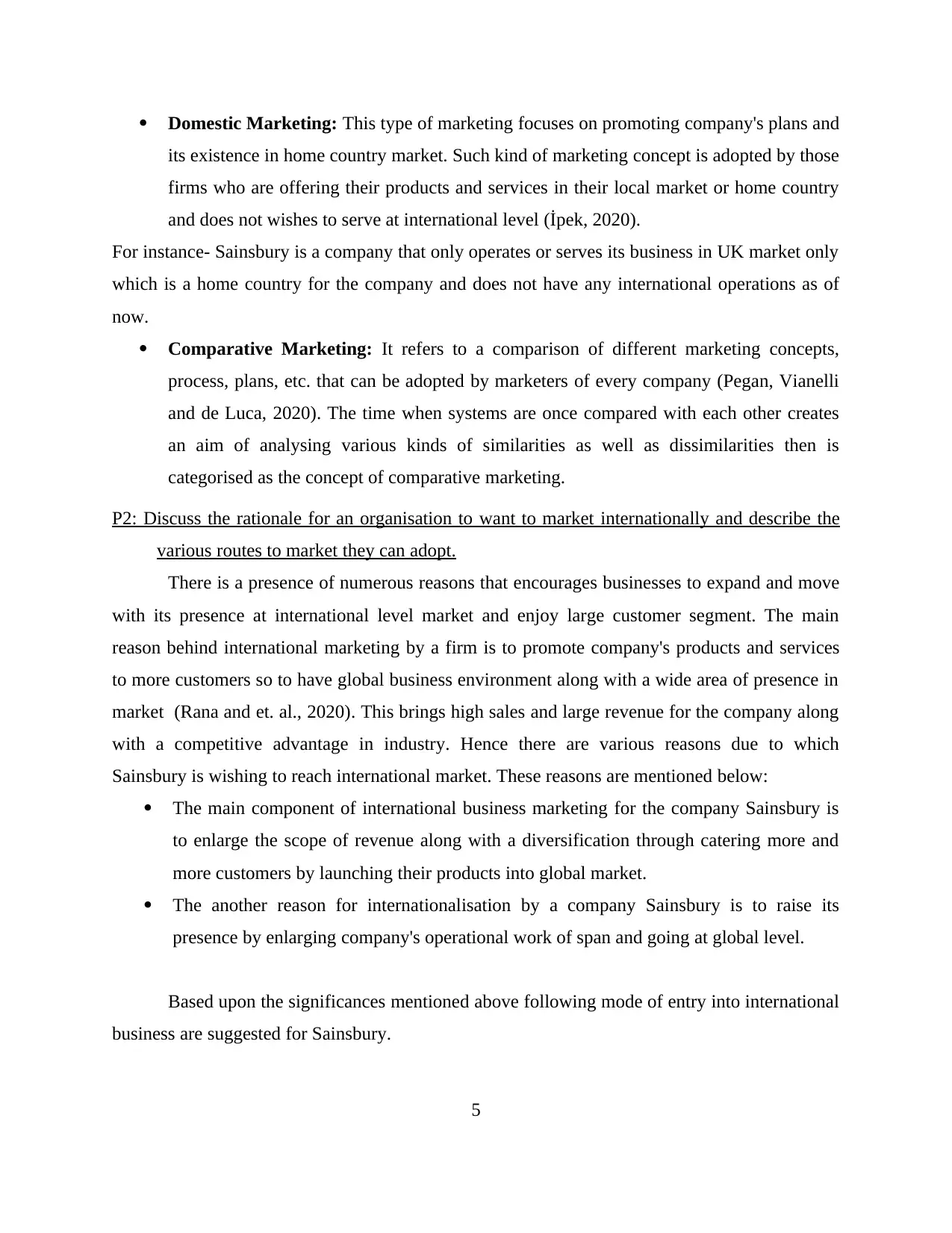
Domestic Marketing: This type of marketing focuses on promoting company's plans and
its existence in home country market. Such kind of marketing concept is adopted by those
firms who are offering their products and services in their local market or home country
and does not wishes to serve at international level (İpek, 2020).
For instance- Sainsbury is a company that only operates or serves its business in UK market only
which is a home country for the company and does not have any international operations as of
now.
Comparative Marketing: It refers to a comparison of different marketing concepts,
process, plans, etc. that can be adopted by marketers of every company (Pegan, Vianelli
and de Luca, 2020). The time when systems are once compared with each other creates
an aim of analysing various kinds of similarities as well as dissimilarities then is
categorised as the concept of comparative marketing.
P2: Discuss the rationale for an organisation to want to market internationally and describe the
various routes to market they can adopt.
There is a presence of numerous reasons that encourages businesses to expand and move
with its presence at international level market and enjoy large customer segment. The main
reason behind international marketing by a firm is to promote company's products and services
to more customers so to have global business environment along with a wide area of presence in
market (Rana and et. al., 2020). This brings high sales and large revenue for the company along
with a competitive advantage in industry. Hence there are various reasons due to which
Sainsbury is wishing to reach international market. These reasons are mentioned below:
The main component of international business marketing for the company Sainsbury is
to enlarge the scope of revenue along with a diversification through catering more and
more customers by launching their products into global market.
The another reason for internationalisation by a company Sainsbury is to raise its
presence by enlarging company's operational work of span and going at global level.
Based upon the significances mentioned above following mode of entry into international
business are suggested for Sainsbury.
5
its existence in home country market. Such kind of marketing concept is adopted by those
firms who are offering their products and services in their local market or home country
and does not wishes to serve at international level (İpek, 2020).
For instance- Sainsbury is a company that only operates or serves its business in UK market only
which is a home country for the company and does not have any international operations as of
now.
Comparative Marketing: It refers to a comparison of different marketing concepts,
process, plans, etc. that can be adopted by marketers of every company (Pegan, Vianelli
and de Luca, 2020). The time when systems are once compared with each other creates
an aim of analysing various kinds of similarities as well as dissimilarities then is
categorised as the concept of comparative marketing.
P2: Discuss the rationale for an organisation to want to market internationally and describe the
various routes to market they can adopt.
There is a presence of numerous reasons that encourages businesses to expand and move
with its presence at international level market and enjoy large customer segment. The main
reason behind international marketing by a firm is to promote company's products and services
to more customers so to have global business environment along with a wide area of presence in
market (Rana and et. al., 2020). This brings high sales and large revenue for the company along
with a competitive advantage in industry. Hence there are various reasons due to which
Sainsbury is wishing to reach international market. These reasons are mentioned below:
The main component of international business marketing for the company Sainsbury is
to enlarge the scope of revenue along with a diversification through catering more and
more customers by launching their products into global market.
The another reason for internationalisation by a company Sainsbury is to raise its
presence by enlarging company's operational work of span and going at global level.
Based upon the significances mentioned above following mode of entry into international
business are suggested for Sainsbury.
5
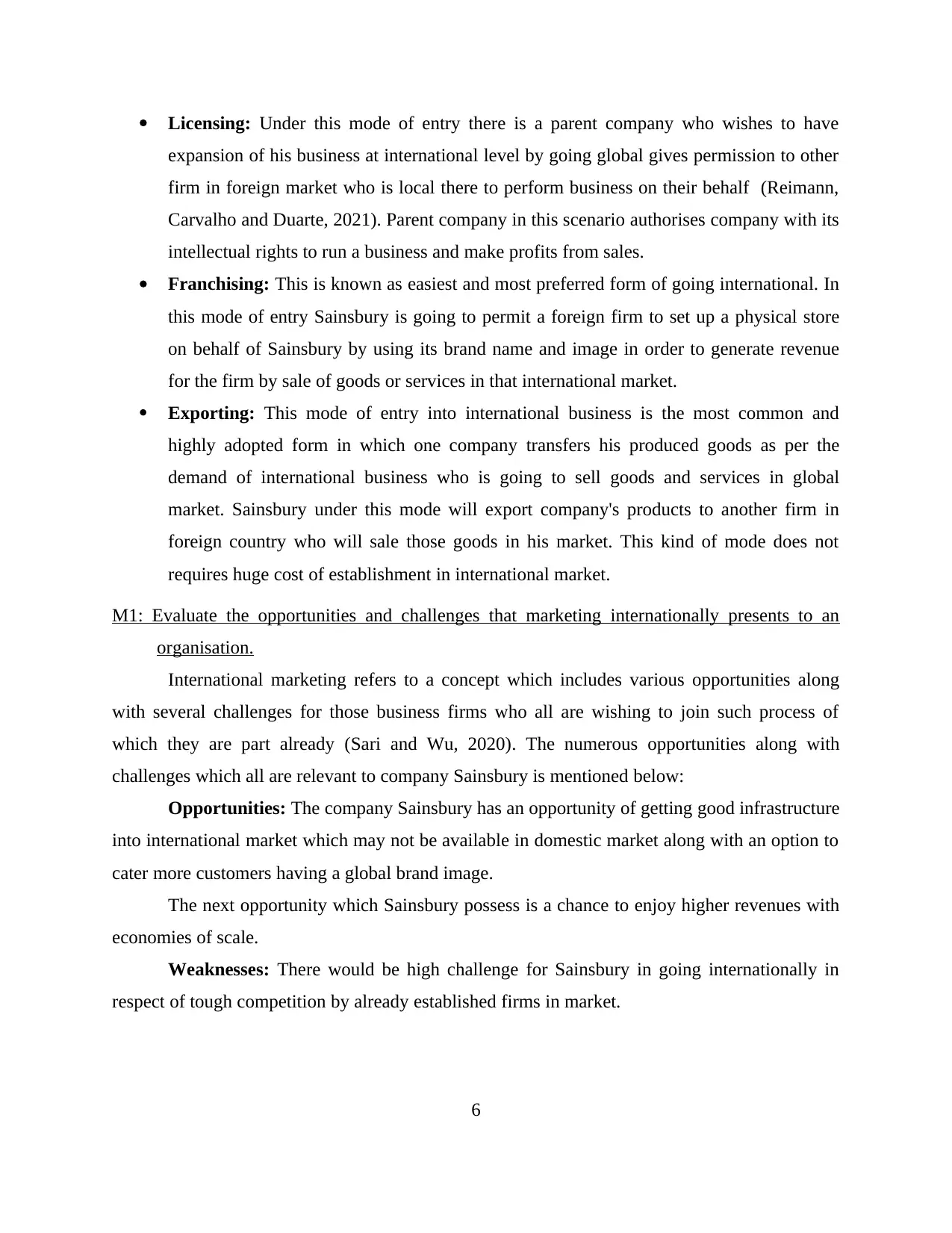
Licensing: Under this mode of entry there is a parent company who wishes to have
expansion of his business at international level by going global gives permission to other
firm in foreign market who is local there to perform business on their behalf (Reimann,
Carvalho and Duarte, 2021). Parent company in this scenario authorises company with its
intellectual rights to run a business and make profits from sales.
Franchising: This is known as easiest and most preferred form of going international. In
this mode of entry Sainsbury is going to permit a foreign firm to set up a physical store
on behalf of Sainsbury by using its brand name and image in order to generate revenue
for the firm by sale of goods or services in that international market.
Exporting: This mode of entry into international business is the most common and
highly adopted form in which one company transfers his produced goods as per the
demand of international business who is going to sell goods and services in global
market. Sainsbury under this mode will export company's products to another firm in
foreign country who will sale those goods in his market. This kind of mode does not
requires huge cost of establishment in international market.
M1: Evaluate the opportunities and challenges that marketing internationally presents to an
organisation.
International marketing refers to a concept which includes various opportunities along
with several challenges for those business firms who all are wishing to join such process of
which they are part already (Sari and Wu, 2020). The numerous opportunities along with
challenges which all are relevant to company Sainsbury is mentioned below:
Opportunities: The company Sainsbury has an opportunity of getting good infrastructure
into international market which may not be available in domestic market along with an option to
cater more customers having a global brand image.
The next opportunity which Sainsbury possess is a chance to enjoy higher revenues with
economies of scale.
Weaknesses: There would be high challenge for Sainsbury in going internationally in
respect of tough competition by already established firms in market.
6
expansion of his business at international level by going global gives permission to other
firm in foreign market who is local there to perform business on their behalf (Reimann,
Carvalho and Duarte, 2021). Parent company in this scenario authorises company with its
intellectual rights to run a business and make profits from sales.
Franchising: This is known as easiest and most preferred form of going international. In
this mode of entry Sainsbury is going to permit a foreign firm to set up a physical store
on behalf of Sainsbury by using its brand name and image in order to generate revenue
for the firm by sale of goods or services in that international market.
Exporting: This mode of entry into international business is the most common and
highly adopted form in which one company transfers his produced goods as per the
demand of international business who is going to sell goods and services in global
market. Sainsbury under this mode will export company's products to another firm in
foreign country who will sale those goods in his market. This kind of mode does not
requires huge cost of establishment in international market.
M1: Evaluate the opportunities and challenges that marketing internationally presents to an
organisation.
International marketing refers to a concept which includes various opportunities along
with several challenges for those business firms who all are wishing to join such process of
which they are part already (Sari and Wu, 2020). The numerous opportunities along with
challenges which all are relevant to company Sainsbury is mentioned below:
Opportunities: The company Sainsbury has an opportunity of getting good infrastructure
into international market which may not be available in domestic market along with an option to
cater more customers having a global brand image.
The next opportunity which Sainsbury possess is a chance to enjoy higher revenues with
economies of scale.
Weaknesses: There would be high challenge for Sainsbury in going internationally in
respect of tough competition by already established firms in market.
6
⊘ This is a preview!⊘
Do you want full access?
Subscribe today to unlock all pages.

Trusted by 1+ million students worldwide
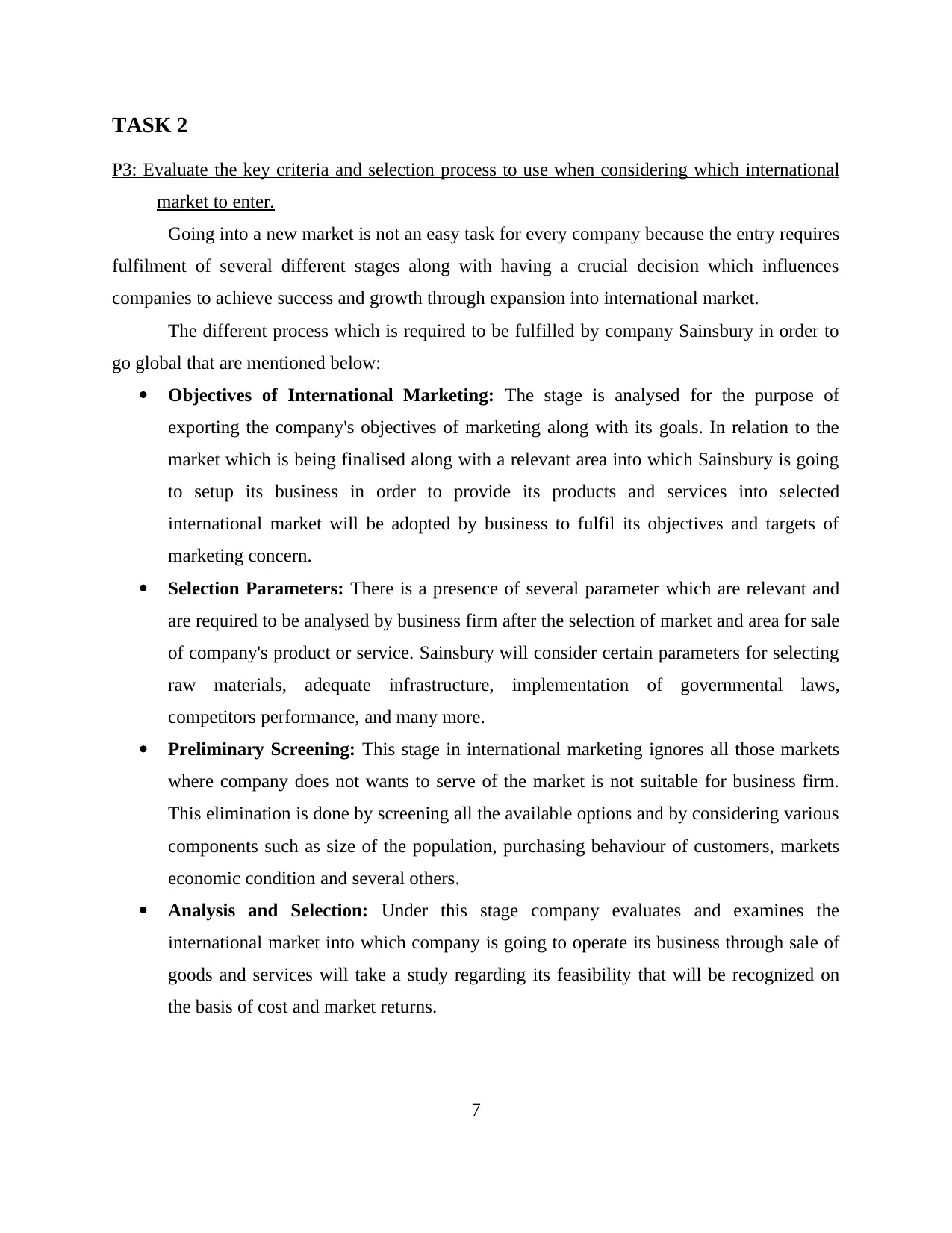
TASK 2
P3: Evaluate the key criteria and selection process to use when considering which international
market to enter.
Going into a new market is not an easy task for every company because the entry requires
fulfilment of several different stages along with having a crucial decision which influences
companies to achieve success and growth through expansion into international market.
The different process which is required to be fulfilled by company Sainsbury in order to
go global that are mentioned below:
Objectives of International Marketing: The stage is analysed for the purpose of
exporting the company's objectives of marketing along with its goals. In relation to the
market which is being finalised along with a relevant area into which Sainsbury is going
to setup its business in order to provide its products and services into selected
international market will be adopted by business to fulfil its objectives and targets of
marketing concern.
Selection Parameters: There is a presence of several parameter which are relevant and
are required to be analysed by business firm after the selection of market and area for sale
of company's product or service. Sainsbury will consider certain parameters for selecting
raw materials, adequate infrastructure, implementation of governmental laws,
competitors performance, and many more.
Preliminary Screening: This stage in international marketing ignores all those markets
where company does not wants to serve of the market is not suitable for business firm.
This elimination is done by screening all the available options and by considering various
components such as size of the population, purchasing behaviour of customers, markets
economic condition and several others.
Analysis and Selection: Under this stage company evaluates and examines the
international market into which company is going to operate its business through sale of
goods and services will take a study regarding its feasibility that will be recognized on
the basis of cost and market returns.
7
P3: Evaluate the key criteria and selection process to use when considering which international
market to enter.
Going into a new market is not an easy task for every company because the entry requires
fulfilment of several different stages along with having a crucial decision which influences
companies to achieve success and growth through expansion into international market.
The different process which is required to be fulfilled by company Sainsbury in order to
go global that are mentioned below:
Objectives of International Marketing: The stage is analysed for the purpose of
exporting the company's objectives of marketing along with its goals. In relation to the
market which is being finalised along with a relevant area into which Sainsbury is going
to setup its business in order to provide its products and services into selected
international market will be adopted by business to fulfil its objectives and targets of
marketing concern.
Selection Parameters: There is a presence of several parameter which are relevant and
are required to be analysed by business firm after the selection of market and area for sale
of company's product or service. Sainsbury will consider certain parameters for selecting
raw materials, adequate infrastructure, implementation of governmental laws,
competitors performance, and many more.
Preliminary Screening: This stage in international marketing ignores all those markets
where company does not wants to serve of the market is not suitable for business firm.
This elimination is done by screening all the available options and by considering various
components such as size of the population, purchasing behaviour of customers, markets
economic condition and several others.
Analysis and Selection: Under this stage company evaluates and examines the
international market into which company is going to operate its business through sale of
goods and services will take a study regarding its feasibility that will be recognized on
the basis of cost and market returns.
7
Paraphrase This Document
Need a fresh take? Get an instant paraphrase of this document with our AI Paraphraser
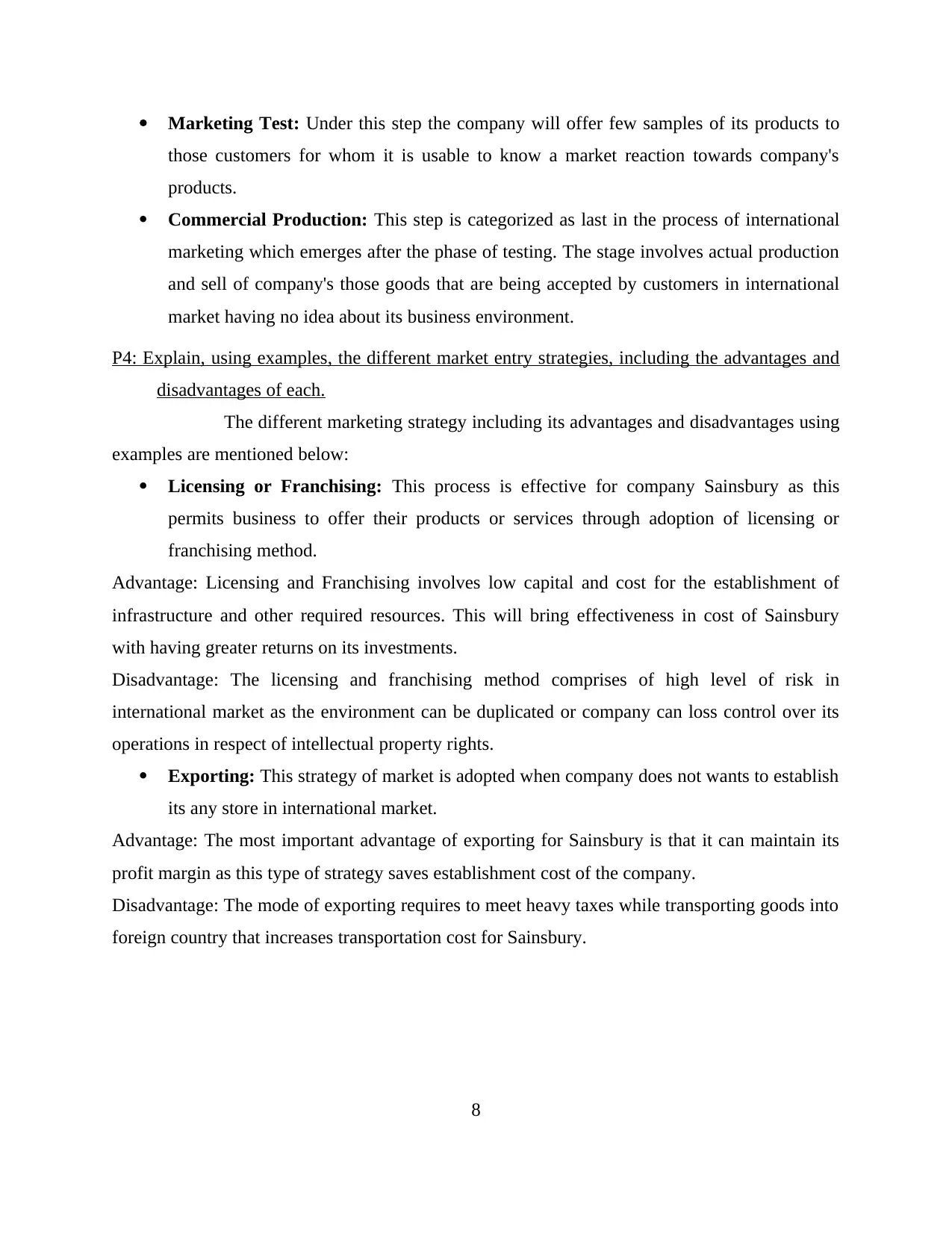
Marketing Test: Under this step the company will offer few samples of its products to
those customers for whom it is usable to know a market reaction towards company's
products.
Commercial Production: This step is categorized as last in the process of international
marketing which emerges after the phase of testing. The stage involves actual production
and sell of company's those goods that are being accepted by customers in international
market having no idea about its business environment.
P4: Explain, using examples, the different market entry strategies, including the advantages and
disadvantages of each.
The different marketing strategy including its advantages and disadvantages using
examples are mentioned below:
Licensing or Franchising: This process is effective for company Sainsbury as this
permits business to offer their products or services through adoption of licensing or
franchising method.
Advantage: Licensing and Franchising involves low capital and cost for the establishment of
infrastructure and other required resources. This will bring effectiveness in cost of Sainsbury
with having greater returns on its investments.
Disadvantage: The licensing and franchising method comprises of high level of risk in
international market as the environment can be duplicated or company can loss control over its
operations in respect of intellectual property rights.
Exporting: This strategy of market is adopted when company does not wants to establish
its any store in international market.
Advantage: The most important advantage of exporting for Sainsbury is that it can maintain its
profit margin as this type of strategy saves establishment cost of the company.
Disadvantage: The mode of exporting requires to meet heavy taxes while transporting goods into
foreign country that increases transportation cost for Sainsbury.
8
those customers for whom it is usable to know a market reaction towards company's
products.
Commercial Production: This step is categorized as last in the process of international
marketing which emerges after the phase of testing. The stage involves actual production
and sell of company's those goods that are being accepted by customers in international
market having no idea about its business environment.
P4: Explain, using examples, the different market entry strategies, including the advantages and
disadvantages of each.
The different marketing strategy including its advantages and disadvantages using
examples are mentioned below:
Licensing or Franchising: This process is effective for company Sainsbury as this
permits business to offer their products or services through adoption of licensing or
franchising method.
Advantage: Licensing and Franchising involves low capital and cost for the establishment of
infrastructure and other required resources. This will bring effectiveness in cost of Sainsbury
with having greater returns on its investments.
Disadvantage: The licensing and franchising method comprises of high level of risk in
international market as the environment can be duplicated or company can loss control over its
operations in respect of intellectual property rights.
Exporting: This strategy of market is adopted when company does not wants to establish
its any store in international market.
Advantage: The most important advantage of exporting for Sainsbury is that it can maintain its
profit margin as this type of strategy saves establishment cost of the company.
Disadvantage: The mode of exporting requires to meet heavy taxes while transporting goods into
foreign country that increases transportation cost for Sainsbury.
8
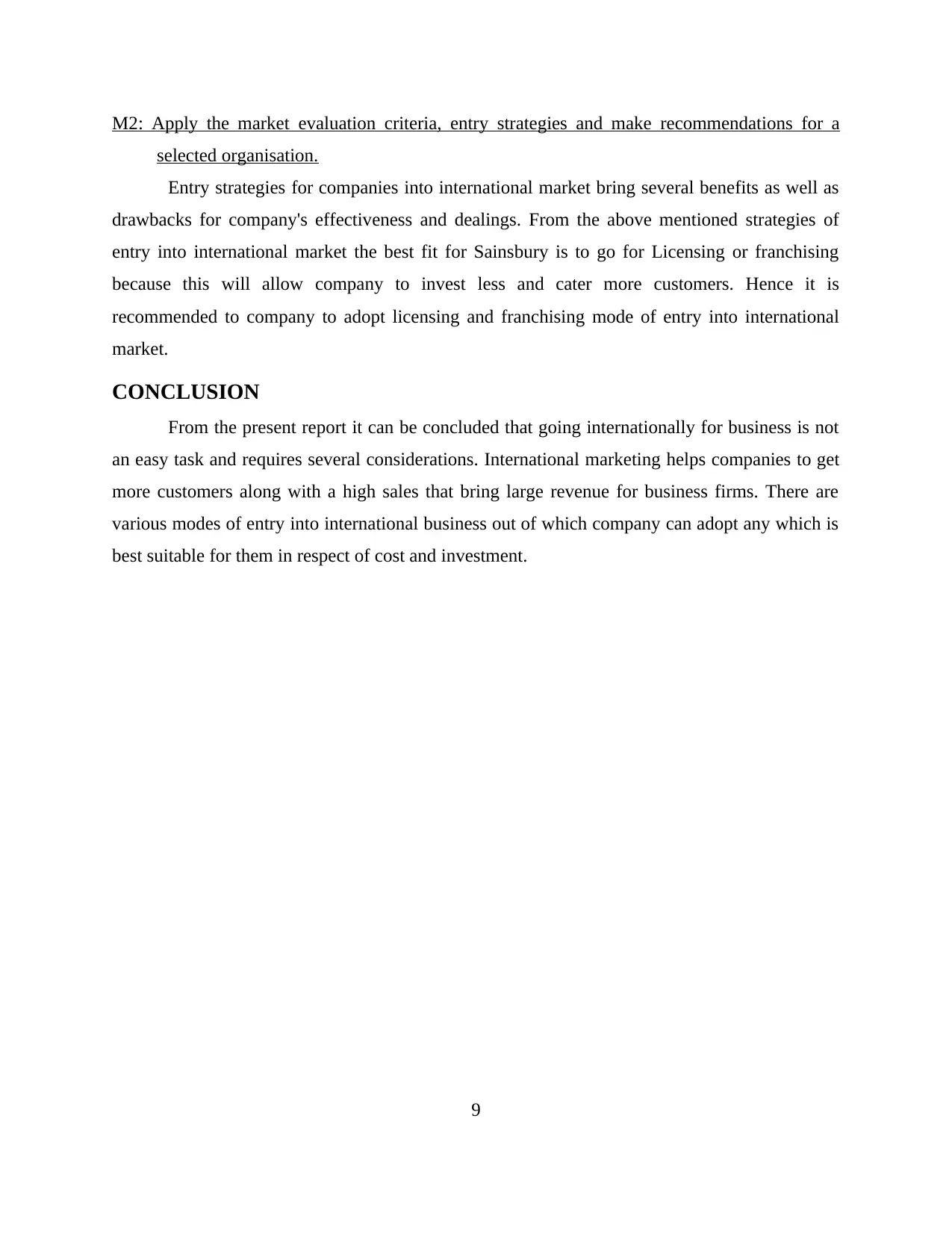
M2: Apply the market evaluation criteria, entry strategies and make recommendations for a
selected organisation.
Entry strategies for companies into international market bring several benefits as well as
drawbacks for company's effectiveness and dealings. From the above mentioned strategies of
entry into international market the best fit for Sainsbury is to go for Licensing or franchising
because this will allow company to invest less and cater more customers. Hence it is
recommended to company to adopt licensing and franchising mode of entry into international
market.
CONCLUSION
From the present report it can be concluded that going internationally for business is not
an easy task and requires several considerations. International marketing helps companies to get
more customers along with a high sales that bring large revenue for business firms. There are
various modes of entry into international business out of which company can adopt any which is
best suitable for them in respect of cost and investment.
9
selected organisation.
Entry strategies for companies into international market bring several benefits as well as
drawbacks for company's effectiveness and dealings. From the above mentioned strategies of
entry into international market the best fit for Sainsbury is to go for Licensing or franchising
because this will allow company to invest less and cater more customers. Hence it is
recommended to company to adopt licensing and franchising mode of entry into international
market.
CONCLUSION
From the present report it can be concluded that going internationally for business is not
an easy task and requires several considerations. International marketing helps companies to get
more customers along with a high sales that bring large revenue for business firms. There are
various modes of entry into international business out of which company can adopt any which is
best suitable for them in respect of cost and investment.
9
⊘ This is a preview!⊘
Do you want full access?
Subscribe today to unlock all pages.

Trusted by 1+ million students worldwide
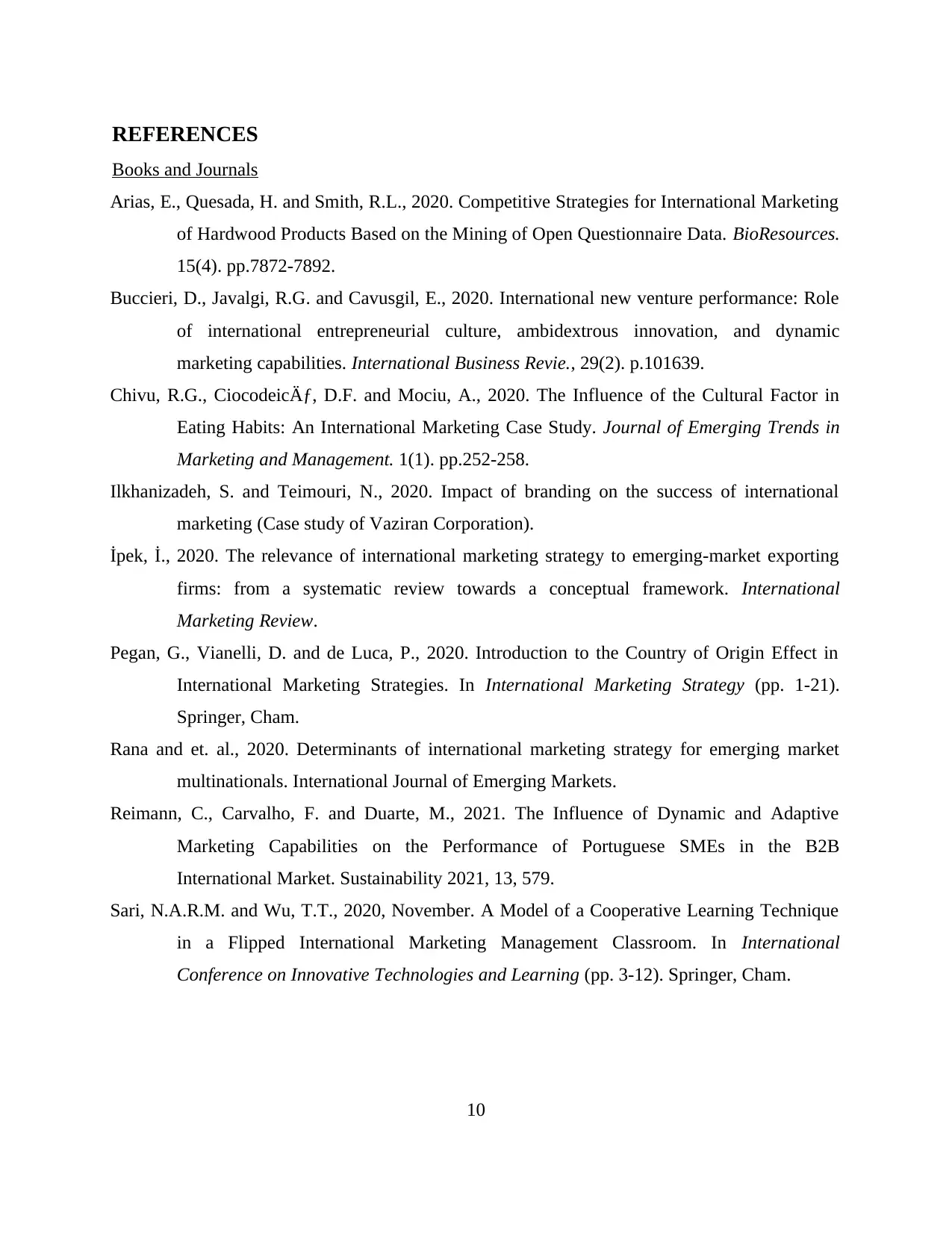
REFERENCES
Books and Journals
Arias, E., Quesada, H. and Smith, R.L., 2020. Competitive Strategies for International Marketing
of Hardwood Products Based on the Mining of Open Questionnaire Data. BioResources.
15(4). pp.7872-7892.
Buccieri, D., Javalgi, R.G. and Cavusgil, E., 2020. International new venture performance: Role
of international entrepreneurial culture, ambidextrous innovation, and dynamic
marketing capabilities. International Business Revie., 29(2). p.101639.
Chivu, R.G., Ciocodeică, D.F. and Mociu, A., 2020. The Influence of the Cultural Factor in
Eating Habits: An International Marketing Case Study. Journal of Emerging Trends in
Marketing and Management. 1(1). pp.252-258.
Ilkhanizadeh, S. and Teimouri, N., 2020. Impact of branding on the success of international
marketing (Case study of Vaziran Corporation).
İpek, İ., 2020. The relevance of international marketing strategy to emerging-market exporting
firms: from a systematic review towards a conceptual framework. International
Marketing Review.
Pegan, G., Vianelli, D. and de Luca, P., 2020. Introduction to the Country of Origin Effect in
International Marketing Strategies. In International Marketing Strategy (pp. 1-21).
Springer, Cham.
Rana and et. al., 2020. Determinants of international marketing strategy for emerging market
multinationals. International Journal of Emerging Markets.
Reimann, C., Carvalho, F. and Duarte, M., 2021. The Influence of Dynamic and Adaptive
Marketing Capabilities on the Performance of Portuguese SMEs in the B2B
International Market. Sustainability 2021, 13, 579.
Sari, N.A.R.M. and Wu, T.T., 2020, November. A Model of a Cooperative Learning Technique
in a Flipped International Marketing Management Classroom. In International
Conference on Innovative Technologies and Learning (pp. 3-12). Springer, Cham.
10
Books and Journals
Arias, E., Quesada, H. and Smith, R.L., 2020. Competitive Strategies for International Marketing
of Hardwood Products Based on the Mining of Open Questionnaire Data. BioResources.
15(4). pp.7872-7892.
Buccieri, D., Javalgi, R.G. and Cavusgil, E., 2020. International new venture performance: Role
of international entrepreneurial culture, ambidextrous innovation, and dynamic
marketing capabilities. International Business Revie., 29(2). p.101639.
Chivu, R.G., Ciocodeică, D.F. and Mociu, A., 2020. The Influence of the Cultural Factor in
Eating Habits: An International Marketing Case Study. Journal of Emerging Trends in
Marketing and Management. 1(1). pp.252-258.
Ilkhanizadeh, S. and Teimouri, N., 2020. Impact of branding on the success of international
marketing (Case study of Vaziran Corporation).
İpek, İ., 2020. The relevance of international marketing strategy to emerging-market exporting
firms: from a systematic review towards a conceptual framework. International
Marketing Review.
Pegan, G., Vianelli, D. and de Luca, P., 2020. Introduction to the Country of Origin Effect in
International Marketing Strategies. In International Marketing Strategy (pp. 1-21).
Springer, Cham.
Rana and et. al., 2020. Determinants of international marketing strategy for emerging market
multinationals. International Journal of Emerging Markets.
Reimann, C., Carvalho, F. and Duarte, M., 2021. The Influence of Dynamic and Adaptive
Marketing Capabilities on the Performance of Portuguese SMEs in the B2B
International Market. Sustainability 2021, 13, 579.
Sari, N.A.R.M. and Wu, T.T., 2020, November. A Model of a Cooperative Learning Technique
in a Flipped International Marketing Management Classroom. In International
Conference on Innovative Technologies and Learning (pp. 3-12). Springer, Cham.
10
1 out of 10
Related Documents
Your All-in-One AI-Powered Toolkit for Academic Success.
+13062052269
info@desklib.com
Available 24*7 on WhatsApp / Email
![[object Object]](/_next/static/media/star-bottom.7253800d.svg)
Unlock your academic potential
Copyright © 2020–2025 A2Z Services. All Rights Reserved. Developed and managed by ZUCOL.




